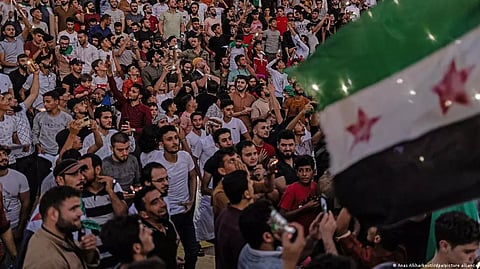

By C Schaer O Albam
WASHINGTON: For the first time in years, the flag of the Syrian revolution has been seen flying in parts of the country still under the control of its authoritarian government. The unexpected sight came during recent anti-government protests in the southern province of Sweida, where up to 2,000 locals have been demonstrating daily for around a fortnight.
“Today, the Assad regime is at its worst and weakest, especially in Sweida,” said one local man who’d been taking part and whose name cannot be published for security reasons. He told DW that locals have long wanted to organize such demonstrations, but that they were prevented by security forces. Syria has been at war since peaceful pro-democracy protests of 2011 were brutally suppressed by the government of dictator Bashar Assad. This month’s protests in Sweida are happening despite the Assad regime’s well-documented history of brutality. Over the past 12 years, it has imprisoned, tortured and killed opponents, bombed civilian marketplaces and hospitals and besieged and starved disloyal communities.
“But these protests will not stop, no matter how much the Assad regime tries,” the Sweida protester told DW. “We are careful and know their despicable and criminal methods.” In Sweida province, home to most of the country’s Druze minority, roads to Damascus have been blocked, government offices closed and the obligatory portraits of Assad removed from buildings.
Protests have spread throughout the province, with locals counting up to 50 events last week. Smaller demonstrations in solidarity with Sweida have also been held in other regime-controlled towns like Daraa near Syria’s border with Jordan.
“We’re out here because the government still holds more than half a million detainees, because of the assassinations, because of the high prices and because of checkpoints where regime militias demand money whenever we pass through,” explained a protester based in Daraa. His name also has been withheld for security reasons. “The protests will continue until the regime is overthrown. It is inevitable,” he insisted. “In Daraa, we’re afraid of being arrested at the checkpoints, but everything else, we’re not afraid.”
“Civilian protests in areas under regime control are so important,” said Radwan al-Atrash, an opposition activist who lives in Idlib, northern Syria, an area not under government control. “We hope Sweida and the entire south don’t stop until they achieve their goal, and we hope protests will spread to the coast as well as Aleppo and Damascus.”
Comments like this have suggested recent events may herald the beginning of a new Syrian revolution.
Smaller protests have broken out sporadically over the past decade, but as some observers pointed out, these latest ones are the most significant in years.
Several factors make these protests particularly noteworthy, British-Syrian political commentator Robin Yassin-Kassab pointed out in a commentary this week. Firstly, an entire Syrian minority now seems to be opposed to the Assad regime, he argued. This is important because of how the Assad government has justified its tactics, arguing that if it gave up power, the country’s minorities would be endangered. Secondly, Yassin-Kassab noted, “the economy has totally collapsed to the point that there will either be revolution or mass starvation.” After over a decade of war, almost 90% of the Syrian population now lives beneath the poverty line, according to the United Nations.